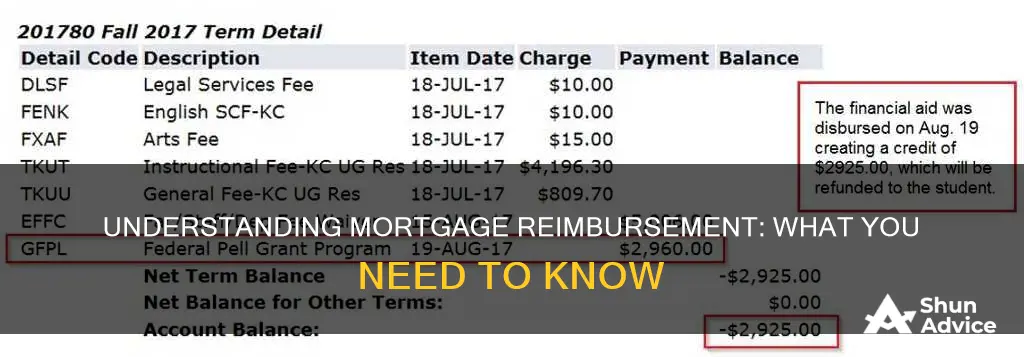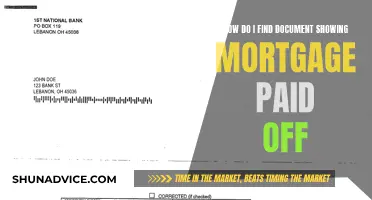
If you're a homeowner, you may have heard of escrow accounts, which are used to manage your property taxes and insurance premiums. An escrow refund is a payment your mortgage servicer may return to you when there is an overage in your escrow account. This can occur when your property taxes decrease, you switch to a less expensive insurance policy, or you pay off your mortgage and have a remaining balance in your escrow account. If you're unsure whether you're eligible for an escrow refund or any other type of mortgage reimbursement, you can contact your mortgage servicer or refer to online resources for more information.
Characteristics and Values of Mortgage Reimbursement
| Characteristics | Values |
|---|---|
| What is a mortgage? | A long-term loan designed to help you buy a house. |
| What is an escrow refund? | A payment your mortgage servicer may return to you when there is an overage in your escrow account. |
| What is an escrow account? | A bank account set up by your mortgage servicer to hold funds for paying property taxes, homeowners insurance and other expenses on your behalf. |
| When do you get an escrow refund? | When your escrow account has excess funds, and you receive a check for any remaining balances. |
| What is included in a mortgage payment? | Principal, interest, taxes, and insurance (PITI). |
| What is PMI? | Private mortgage insurance, which is mandatory if you buy a home with a down payment of less than 20%. |
| What is FHA? | Federal Housing Administration, a part of the U.S. Department of Housing and Urban Development. |
| Who is eligible for an FHA refund? | Homeowners with an FHA-insured mortgage. |
What You'll Learn

Escrow refunds
An escrow account is a legal arrangement where a neutral third party holds funds in a secure place to cover insurance and taxes. It is used to manage your property taxes and insurance premiums. The escrow account is set up by your mortgage servicer to hold funds for paying property taxes, homeowners insurance, and other expenses on your behalf.
An escrow refund is a payment your mortgage servicer issues when there are excess funds in your escrow account following an annual account review. This can occur when the escrow analysis shows a surplus, meaning you are paying more into the escrow account than you need to. It can also occur when you have paid off your mortgage completely and have a remaining balance in your escrow account. In this case, the servicer will refund the remaining balance of your escrow account within 20 days.
It's important to note that escrow refunds are relatively rare and typically occur after an annual escrow account analysis. The timing can vary, but it usually happens in the month of December. If you are eligible for an escrow refund, the loan servicer will issue a check for the excess funds in your escrow account.
Finding Assumable Mortgages: Strategies for Success
You may want to see also

FHA-insured mortgage refunds
If you had an FHA-insured mortgage, you may be eligible for a refund from the US Department of Housing and Urban Development (HUD) or the Federal Housing Administration (FHA). The HUD's Office of Financial Services – Single-Family Insurance Operations Division (SFIOD) is responsible for paying eligible homeowner refunds or distributive share payments.
To be eligible for an FHA MIP refund, you must meet the following criteria:
- You must have closed on your FHA loan within the last 3 years.
- You must be current on your mortgage payments.
- You cannot have any foreclosures listed on your credit report.
- You can only get an MIP refund if you refinance your loan into another FHA-insured loan.
The amount of refund you receive depends on how long you wait to refinance. If you refinance within 12 months, you will receive a refund of 58% of your upfront payment. If you wait 3 years before refinancing, you will receive a refund of 10% of your upfront payment. It is important to note that you will not receive your refund as a cash payment. Instead, your refund will be applied to the upfront Mortgage Insurance Premium (MIP) payment you need to make when you refinance to a new FHA loan.
If you are eligible for a refund, HUD will either request that the Department of the Treasury issue a check directly to you or send you an Application for Premium Refund or Distributive Share Payment (form HUD-27050-B). You can also submit all documentation related to your application for a mortgage insurance premium refund to the FHA via email, fax, or mail.
Understanding Your Mortgage: Finding the Principal Balance
You may want to see also

Private mortgage insurance
PMI is arranged by the lender and provided by private insurance companies. It is an extra expense for borrowers and increases the cost of the loan. You can request to cancel PMI when your mortgage balance reaches 80% of your home's value. If you don't make this request, lenders are required to cancel PMI when your balance reaches 78% of your home's value or when you're halfway through the loan term.
There are a few ways to avoid PMI without making a 20% down payment. One option is to take out an 80-10-10 loan, also called a piggyback loan, where you make a 10% down payment and have two mortgages that cover the other 90%. Another option is to consider a government-backed loan, such as an FHA or USDA loan, which do not require PMI but do have their own associated fees.
PMI can help you qualify for a loan that you might not otherwise be able to get, but it is important to understand the structure of your mortgage payments and the associated costs.
Finding Your Mortgage Statement: A Simple Guide
You may want to see also

Annual escrow account analysis
An annual escrow account analysis is a review of your escrow account to ensure that there are sufficient funds to cover your taxes and insurance premiums. It includes a review of the account activity over the past year and projections for the next 12 months. The analysis determines if there is a surplus or a shortage in the account, which can impact your monthly mortgage payments.
The analysis covers various aspects of your escrow account, including your balance, monthly payment amount, and minimum required balance. It also includes details of recent tax and insurance payments made from the account and projected amounts for the upcoming year. Additionally, it outlines any changes to your monthly payments, specifically related to taxes and insurance.
If the analysis reveals a surplus in your escrow account, your lender may send you a check for the difference. On the other hand, if there is a shortage, your monthly payments may be adjusted to make up for the shortfall. This adjustment is typically made over a 12-month period, with a portion of the shortage amount added to your monthly payments.
It's important to note that you can take steps to lower your monthly mortgage payments if they become higher than you're comfortable with. You can shop around for a new insurer or refinance your mortgage to a lower interest rate. Additionally, you can explore options to reduce your insurance premium or remove private mortgage insurance if certain conditions are met.
To understand your annual escrow analysis better, you can refer to resources provided by your lender or seek assistance from their customer care team. These resources can help you interpret the information in your analysis statement and answer any questions you may have.
Accessing Your Mortgage Statement: A Quick Guide
You may want to see also

Mortgage reimbursement eligibility
An escrow refund is a payment your mortgage servicer may return to you when there is an overage in your escrow account. These bank accounts are set up by your mortgage servicer to hold funds for paying property taxes, homeowners insurance, and other expenses on your behalf. If you've received an escrow refund check, the money is yours to keep and use as you desire.
Escrow refunds are relatively rare but can occur for several reasons. One reason could be that you prepaid your first mortgage payment, part of your property taxes, and maybe some or all of your homeowner's insurance at the time you signed your mortgage documents. Another reason could be that you receive a discount on your insurance rate or switch to a less expensive homeowner's insurance policy. Lowered tax bills may also result in an escrow refund.
At the end of each year, the servicer reviews your escrow account to ensure sufficient funds for the next year's expenses. If the balance exceeds what is needed, the lender may refund the difference to you. You may also receive an escrow refund check if you refinance into a new loan and close your current escrow account or when you pay off your mortgage.
If you had an FHA-insured mortgage, you may be eligible for a refund from the US Department of Housing and Urban Development's Federal Housing Administration (FHA). You can submit all documentation related to your application for a mortgage insurance premium refund to the FHA via email, fax, or the Premium Refund Application Upload webpage.
Finding Non-Recourse Mortgages: What You Need to Know
You may want to see also
Frequently asked questions
An escrow refund is a payment your mortgage servicer may return to you when there is an overage in your escrow account. Escrow accounts are set up by your mortgage servicer to hold funds for paying property taxes, homeowners insurance and other expenses on your behalf.
Escrow refunds are relatively rare. You will get an escrow refund when your escrow account contains excess funds and you receive a check for any remaining balances. This could happen if your property taxes go down or you switch to a less expensive homeowners insurance policy. You will also get an escrow refund if you refinance into a new loan and close your current escrow account.
You can check the list of names of people owed a refund by the U.S. Department of Housing and Urban Development’s Federal Housing Administration (FHA). If your name appears on the list, call (800) 697-6967 for more information.







